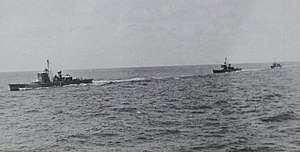No.1-class submarine chaser
The No. 1-class submarine chaser (第一号型駆潜艇,, Dai 1 Gō-gata Kusentei) was a class of submarine chasers of the Imperial Japanese Navy (IJN), serving during World War II. Three vessels were built in 1933-36 under the Maru 1 Programme and the Maru 2 Programme. They have two sub classes; this article handles them collectively.
 (left to right) No. 1, No. 2 and No. 3 in 1938 | |
| Class overview | |
|---|---|
| Name: |
|
| Builders: |
|
| Operators: |
|
| Succeeded by: | No. 4-class |
| Cost: |
|
| Built: | 1933 – 1936 |
| In commission: | 1934 – 1946 |
| Planned: | 3 |
| Completed: | 3 |
| Lost: | 1 |
| Retired: | 2 |
| General characteristics No. 1-class | |
| Displacement: |
|
| Length: |
|
| Beam: | 5.90 m (19 ft 4 in) |
| Draught: | 1.43 m (4 ft 8 in) |
| Propulsion: |
|
| Speed: | |
| Range: | 1,500 nmi (2,800 km) at 14 kn (16 mph; 26 km/h) |
| Complement: | 65 |
| Armament: |
|
| General characteristics No. 3-class | |
| Displacement: |
|
| Length: |
|
| Beam: | 5.60 m (18 ft 4 in) |
| Draught: | 2.10 m (6 ft 11 in) |
| Propulsion: |
|
| Speed: | 20.0 knots (23.0 mph; 37.0 km/h) |
| Range: | 1,500 nmi (2,800 km) at 14 kn (16 mph; 26 km/h) |
| Complement: | 60 |
| Armament: |
|
Background
- In World War I, German U-boat raged. The IJN began maintenance of an anti-submarine boat as a lesson in this, because Japanese shoreline and sea-lanes were very long. The IJN had some submarine chaser type tugboats and yard ferries. However, they were small and their speed was low.
- The IJN wanted to give the anti-submarine boats a speed of more than 20 knots, because their Kaidai III submarine already achieved a 20kt surfaced.
Design
- The Naval Technical Department (Kampon) made draft shallow to give them high speed. They achieved 24 kt speed hereby.
- The No. 1 and the No. 2 were completed in March 1934, and they were assigned to the 1st Subchaser Division, Yokosuka Naval Defence Squadron.
- However, because of their very shallow draft they lacked the rolling performance. This fact become evident after the Tomozuru incident.
- The Tomozuru incident affected the No. 1-class. The No. 1 and the No. 2 were sent to the Uraga Dock Company in July 1934, and repairs were started. They were equipped 80 tons ballast and mounted a ballast keel. The drawings for the No. 3-class boat was also revised.
Service
- Late 1934, Repairs were completed.
- October 1936, The No. 3 assigned to 1st SchDiv. They always shared an action afterward.
- In 1938, the 1st SchDiv was transferred to the No. 1 Base Force (Shanghai).
- On 5 September 1941, the No. 1 Base Force was transferred to the 2nd Fleet.
- In December 1941 – March 1942, the 1st SchDiv engaged to the Battle of the Philippines and Dutch East Indies campaign.
- On 10 March 1942, the 1st SchDiv was transferred to the No. 21 Special Base Force (Surabaya), 2nd Southern Expeditionary Fleet, Southwest Area Fleet.
- On 1 May 1942: The 1st SchDiv was dissolved. They spent all their time for escort operations in the Java Area.
Ships in classes
No.1-class
- Project number was K3. 2 vessels were built under the Maru 1 Programme. They equipped the MV hydrophone by Submarine signal company and latest active sonar the Type 93.
| Ship | Builder | Laid down | Launched | Completed | Fate |
| No. 1[1] | Uraga Dock Company | 19 June 1933 | 23 December 1933 | 24 March 1934 | Scuttled by Royal Navy off Singapore on 11 July 1946. Decommissioned on 10 August 1946. |
| No. 2 | Tōkyō Ishikawajima Shipyard | 9 June 1933 | 20 December 1933 | 25 March 1934 | Sunk by USS Blueback at north of Lombok on 27 June 1945. |
No.3-class
- Project number was K4. Only 1 vessel was built under the Maru 2 Programme. The No. 3 was equipped the French SCAM active sonar and latest hydrophone the Type 93. The No. 3 was classed in the No. 1-class in the IJN official documents.
| Ship | Builder | Laid down | Launched | Completed | Fate |
| No. 3 | Asano Shipyard | 17 April 1935 | 6 June 1936 | 5 October 1936 | Scuttled by Royal Navy off Singapore on 11 July 1946. Decommissioned on 10 August 1946. |
Photos
 No. 2 in 1934
No. 2 in 1934 No. 3 in 1936
No. 3 in 1936
Footnotes
- Submarine chaser No. 1 (第1号駆潜艇, Dai 1 Gō Kusentei). The same shall apply hereinafter.
Bibliography
- Ships of the World special issue Vol. 45, Escort Vessels of the Imperial Japanese Navy, "Kaijinsha"., (Japan), 1996.
- The Maru Special, Japanese Naval Vessels No. 49, Japanese submarine chasers and patrol boats, "Ushio Shobō". (Japan), 1981.
gollark: Anyway, OBSERVE video0.mov.
gollark: Now it works?!
gollark: <@711227962401226793>
gollark: Odd.
gollark: My client is not showing those as pings.
This article is issued from Wikipedia. The text is licensed under Creative Commons - Attribution - Sharealike. Additional terms may apply for the media files.